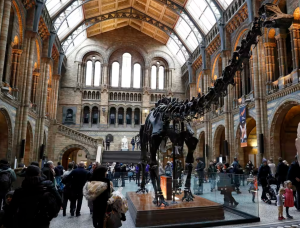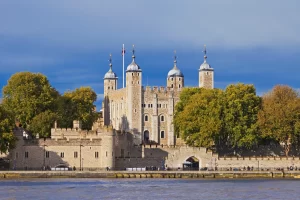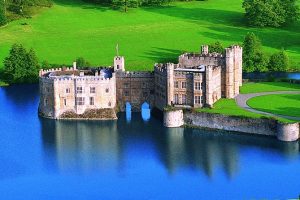Cheddar Gorge, located in the Mendip Hills in Somerset, England, is renowned for its stunning natural beauty and impressive limestone cliffs. It is also the birthplace of the world-famous Cheddar cheese, which has been produced in the region for centuries. The gorge offers picturesque walking trails, fascinating caves, and breathtaking panoramic views, making it a popular destination for nature enthusiasts and history buffs alike.


The Natural History Museum in London is located near Harrods, the store of the super rich. This world-renowned museum houses a vast collection of specimens from various aspects of natural history, including botany, entomology, mineralogy, paleontology, and zoology. Its iconic Victorian architecture, featuring a striking Romanesque design, provides a captivating backdrop for the diverse exhibits and interactive displays. The museum’s highlights include the popular dinosaur gallery, the famous blue whale skeleton, and numerous interactive learning experiences for visitors of all ages. Entrance to the museum is free, making it a must-visit destination for both tourists and locals alike.
Buckingham Palace has a rich history that dates back to the early 18th century when it was originally constructed as a large townhouse for the Duke of Buckingham. It was later acquired by King George III in 1761 as a private residence for Queen Charlotte and was then known as “The Queen’s House.” In the 19th century, under the reign of King George IV, extensive renovations and expansions were carried out, transforming it into the magnificent palace known today. The palace has since served as the official London residence of Britain’s sovereigns, making it an iconic symbol of the British monarchy and an essential part of the United Kingdom’s rich heritage. If the Monarch is home, the Royal flag is raised, if not it will be the Union Flag


St Paul’s Cathedral is an iconic architectural masterpiece located in the heart of London. This magnificent cathedral holds great historical significance, and it’s no wonder that it was chosen as the venue for the wedding of Princess Diana and Prince Charles. The grandeur and solemn beauty of St Paul’s Cathedral have made it a popular attraction for visitors from around the world. Its rich history, stunning architecture, and role as the backdrop for significant events have secured its place as a must-visit destination in London
Westminster Abbey is a historic church located in London, England. It is known for its stunning Gothic architecture and has been the traditional location for coronations and burials for English and, later, British monarchs. The abbey has also been the setting for many royal weddings, including the wedding of Prince William and Catherine Middleton. It is a UNESCO World Heritage Site and a popular tourist attraction, drawing visitors from around the world who come to admire its architecture, learn about its history, and pay homage to the notable figures buried within its walls.


The Houses of Parliament is more of a description than a name. There is some confusion as to what to call it.
The Houses of Parliament are strictly speaking, what it contains. The House of Commons and The House of Lords. The building itself is The Palace of Westminster. Attached to it is what many call ‘Big Ben’, again, this isn’t the name but the contents. Big Ben is the name of the largest bell inside the Elizabeth Tower.
In this picture, just to the right of the Elizabeth Tower can be seen the twin white towers of Westminster Abbey.
The bridge is not very originally named ‘Westminster Bridge’ and is one of many which cross the Thames. The first of those is not tower Bridge as many think but actually the Queen Elizabeth Bridge which connects the counties of Essex and Kent East of London.
The history of the Tower Bridge in London dates back to the late 19th century. Designed by Sir Horace Jones and engineer Sir John Wolfe Barry, it took 8 years to construct and was completed in 1894. The bridge’s design was a solution to the increasing traffic in London while still allowing large ships to access the port facilities. Its iconic look with two towers, drawbridge, and Gothic architectural elements has made it a renowned symbol of the city. Today, the Tower Bridge is not only a vital crossing over the River Thames but also a popular tourist attraction, offering magnificent views of the London skyline.

The Tower of London, officially known as His Majesty’s Royal Palace and Fortress of the Tower of London, is a historic castle located on the north bank of the River Thames in central London next to Tower Bridge, England. Its origins date back to the Norman Conquest of England in the 11th century when William the Conqueror began building the White Tower in 1078 as a symbol of power and as a stronghold to control the city of London.
Over the centuries, the Tower has served various purposes including royal residence, armory, treasury, menagerie, and most notably, as a prison. It gained a notorious reputation as a place of imprisonment, torture, and execution, with famous prisoners including Anne Boleyn, Lady Jane Grey, and Sir Walter Raleigh.
In addition to its grim history as a prison, the Tower of London has also served as a royal mint, a public records office, and a home to the Crown Jewels of England which are securely housed within the Jewel House. Today, the Tower of London is a popular tourist attraction and a UNESCO World Heritage Site, drawing visitors from around the world to explore its rich history and imposing architecture.


Hampton Court Palace is a historic royal palace located in the borough of Richmond upon Thames, London, UK. This magnificent palace has a rich history, with its origins dating back to the early 16th century. It is closely associated with King Henry VIII, who extensively expanded and renovated the palace during his reign.
King Henry VIII is perhaps best known for his six marriages and his role in the English Reformation. His connection to Hampton Court Palace is significant not only because of the extensive building works he undertook, but also because of the various events and intrigues that unfolded within its walls during his reign.
The palace is a remarkable example of Tudor architecture and boasts stunning gardens, intricate courtyards, and impressive state apartments. Visitors to Hampton Court Palace can immerse themselves in its rich history, exploring the opulent Tudor kitchens, the Great Hall, and the beautiful Chapel Royal, among other attractions.
Overall, Hampton Court Palace stands as a testament to the grandeur and power of the Tudor monarchs, particularly King Henry VIII, and continues to attract visitors from around the world who are eager to experience a piece of England’s royal history.

Leeds Castle, located in Kent, is often referred to as the “loveliest castle in the world.” This enchanting fortress has a rich history dating back to the 9th century and has been home to royalty, including King Edward I and Henry VIII’s first wife, Catherine of Aragon. The castle is surrounded by stunning gardens, a moat, and offers picturesque views of the surrounding landscape. It is a popular tourist destination and hosts various events and activities throughout the year, making it a must-visit for history enthusiasts and admirers of breathtaking architecture.
Warwick Castle is a medieval castle located in Warwick, the county town of Warwickshire, England. It was originally built by William the Conqueror in 1068 and has undergone numerous renovations and expansions throughout its long history. The castle is known for its well-preserved state and its beautiful architecture, making it a popular tourist attraction. In addition to guided tours of the castle and its grounds, visitors can also enjoy various events and activities, including falconry displays, archery, and jousting tournaments. The castle also offers stunning views of the River Avon.


Bamburgh Castle
Bamburgh Castle is a historic fortress located on the coast of Northumberland, England. With a history dating back to the 5th century, it has been a site of strategic importance and has witnessed various phases of construction and renovation. The castle stands on a basalt outcrop, offering stunning views of the surrounding area and the North Sea. It has played a significant role in battles and conflicts throughout the centuries, making it an iconic symbol of Northumberland’s heritage. Today, Bamburgh Castle is a popular tourist attraction, offering visitors a glimpse into its rich history and breath taking architecture.
Dover Castle
Dover Castle is a medieval fortress located in the town of Dover, Kent, in the southeast of England. It is the largest castle in England and has a rich history dating back to the 11th century. The site features defensive earthworks, a Roman lighthouse, and a Saxon church, showcasing its significance throughout different periods of history. The castle played a crucial role in defending the English coastline and was often referred to as the “Key to England” due to its strategic location. Today, it is a popular historical attraction, offering visitors the opportunity to explore its well-preserved structures and learn about its compelling past.


The Peak District National Park is located in central England and is known for its stunning natural landscapes, including rugged peaks, open moorlands, and gentle valleys. It is renowned for its outdoor recreational opportunities such as hiking, rock climbing, and cycling. The park also boasts picturesque villages, historic landmarks, and diverse wildlife, making it a popular destination for nature lovers and outdoor enthusiasts.
The County of Cornwall
The County of Cornwall, located in the southwestern tip of England, is known for its stunning coastline, rugged moorland, and picturesque villages. With a rich history and distinct cultural heritage, Cornwall offers visitors a unique blend of natural beauty and traditional charm.
Cornwall is home to the famous Tintagel Castle, linked to the legend of King Arthur, as well as the enchanting Eden Project, showcasing a variety of plants from different climates. The region’s culinary scene features delicious seafood, traditional Cornish pasties, and local cream teas.
In addition to its natural and historical attractions, Cornwall hosts a range of events and festivals throughout the year, celebrating everything from folk music to surfing. Whether exploring its scenic landscapes, enjoying its cultural offerings, or simply relaxing on its sandy beaches, Cornwall beckons travellers with its timeless allure.


The Wye Valley is a picturesque area located on the border between England and Wales, following the path of the River Wye. This stunning landscape is known for its dramatic limestone cliffs, dense woodlands, and charming market towns. The valley is a popular destination for outdoor enthusiasts, offering opportunities for hiking, canoeing, and cycling. Additionally, the area is home to Tintern Abbey, a magnificent 12th-century ruin that draws visitors from around the world. With its rich natural beauty and historical landmarks, the Wye Valley holds a special allure for those seeking a tranquil escape in the midst of striking scenery.
British food is known for its hearty and comforting dishes, often influenced by the country’s history and diverse culinary traditions. Traditional British cuisine includes iconic dishes such as fish and chips, shepherd’s pie, bangers and mash, roast beef with Yorkshire pudding, and the famous English breakfast. The use of locally sourced ingredients and a focus on simple, flavourful cooking are characteristic of British food. In recent years, there has been a surge in modern British cuisine, with chefs putting a contemporary spin on classic dishes and embracing global flavours while still celebrating the rich culinary heritage of the UK. It is worth remembering the multicultural nature of the United Kingdom. It would be quite accurate to say that the most popular ‘British’ dish is actually the Chicken Tikka Masala. Though that meal has some base origin in India, it is entirely a British creation.
Many different cultures have integrated their food into British cuisine. Many will eat meals from all over the world and it is common to do so. We value our traditional meals but we are not slaves to them.


The Union Flag is the combined flag of the United Kingdom. It incorporates the flags of England, Scotland and Northern Ireland. Confusingly, the flag of Wales is not included because, by the time the flag was designed, Wales and England had already combined.
Sometimes referred to the Union ‘Jack’ but, this is incorrect. The ‘Jack’ is just the flag as flown on a naval vessel. Elsewhere it is the Union Flag.
